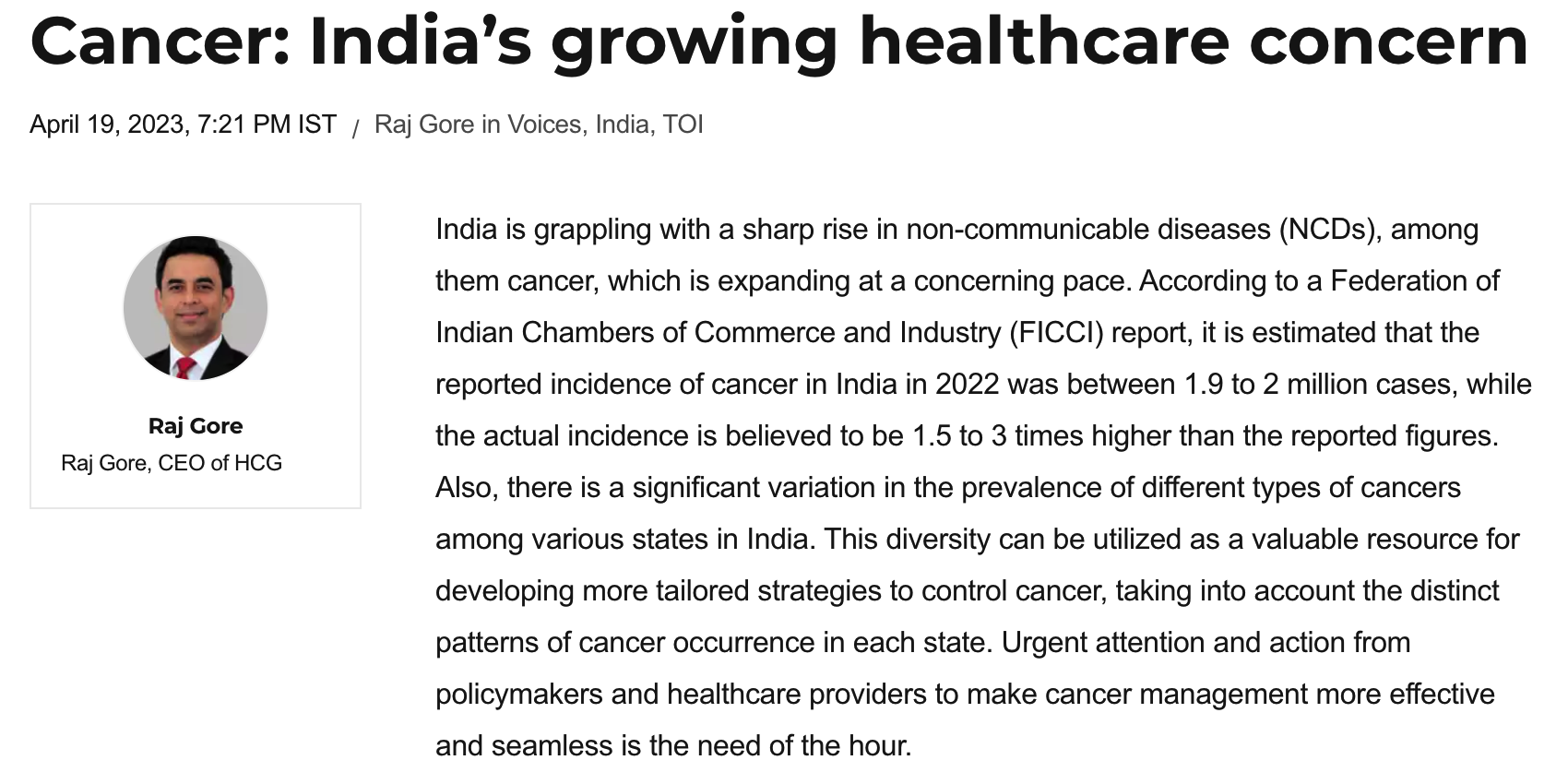
Cancer: India's growing healthcare concern
India is grappling with a sharp rise in non-communicable diseases (NCDs), among them cancer, which is expanding at a concerning pace. According to a Federation of Indian Chambers of Commerce and Industry (FICCI) report, it is estimated that the reported incidence of cancer in India in 2022 was between 1.9 to 2 million cases, while the actual incidence is believed to be 1.5 to 3 times higher than the reported figures. Also, there is a significant variation in the prevalence of different types of cancers among various states in India. This diversity can be utilized as a valuable resource for developing more tailored strategies to control cancer, taking into account the distinct patterns of cancer occurrence in each state. Urgent attention and action from policymakers and healthcare providers to make cancer management more effective and seamless is the need of the hour.
Addressing the surge
Cancer management involves a multifaceted approach that includes awareness, education, prevention, early detection, treatment, and support for those affected. Public awareness campaigns aimed at promoting healthy lifestyles, such as quitting smoking, exercising regularly, and eating a balanced diet, are important initiatives to prevent cancer. Campaigns like 'Raho cancer se do kadam aage' and 'Roko cancer' aim to increase public awareness about cancer and the importance of early detection. These national interventions educate individuals on the disease and the available treatments. Such campaigns are essential to promote early diagnosis and improve survival rates.
Prevention is better than cure
Many cancers are preventable. Primary prevention should be aimed at reducing exposure to carcinogens such as quitting smoking, restricting alcohol consumption, adopting a healthy diet, engaging in regular physical activity, minimizing exposure to radiation, and getting vaccinated against HPV.
Most of the 1.9 to 2 million new cases of cancer every year are diagnosed at advanced stages requiring multimodal treatment. And considering the impact cancer has on the lives of the patient, the family, its finances, and the social burden, it is imperative that no effort should be spared to help preventable cancers from setting in. The combination of late-stage identification and inadequate availability of comprehensive, high-quality cancer treatment significantly affects the results of cancer treatment in the country.
Cancer treatment incurs the highest financial burden among all diseases, with the cost of a single hospitalization for cancer exceeding the average annual expenditure of 80% of the population in 2017. To reduce out-of-pocket expenses, insurance is crucial. Thus, policymakers and healthcare providers must prioritize cost-effectiveness, driven by a culture of continuous improvement, when designing future healthcare delivery models.
Enforce tobacco restrictions
A common refrain ? and scientifically backed too ? is that use of tobacco is a major cause for cancer, and consequently, of death from cancer. Despite relatively high levels of awareness compared to other risk factors, tobacco usage remains a significant public health challenge in India. India is home to more than 267 million tobacco users, making it the country with the second-largest tobacco user base in the world, next only to China. While the government has taken steps to control tobacco use through the National Tobacco Control Program and the implementation of the Cigarettes and Other Tobacco Products Act, the prevalence of adult tobacco users in India remains high, at 28.6%, which is higher than the global average of 23.4%.
A clear call to action for governments and authorities is to implement and enforce policies that restrict the use of tobacco products. These policies may include measures such as increasing the taxes on tobacco products, and banning smoking in public places. The aim is to reduce the prevalence of smoking and tobacco use, which is a leading cause of preventable deaths worldwide, and improve public health.
The next level of prevention is Secondary prevention. This involves early detection of cancer through a grassroots approach at the village and community levels. Early diagnosis can lead to better outcomes. Government machinery, both private and public, would need to work seamlessly to deliver quality healthcare and promote early diagnosis.
In India, the population coverage for cancer screening is low, at less than 2%. This is primarily due to a lack of awareness about the importance of early detection. India needs to launch a campaign to significantly raise awareness about prevention, early detection, and treatment of cancer. This should include promoting the use of automated diagnostic tools, precision medicine, and personalized care, which can ultimately make cancer care more affordable for patients.
In conclusion, India is confronted with a considerable challenge posed by a substantial burden of cancer incidence, which is steadily increasing. Tailored strategies are needed, including awareness campaigns, prevention, early detection, and comprehensive treatment. Policymakers must prioritize comprehensive and effective treatment covered through insurance to reduce the financial burden and ensure quality healthcare.